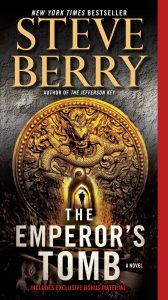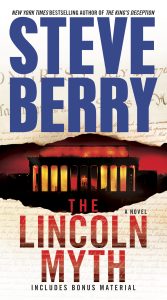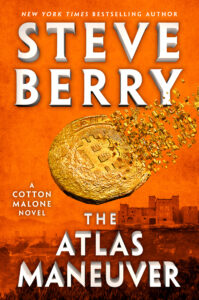The Warsaw Protocol
Cotton Malone Series Book 15
 Buy the Book:
Buy the Book:Amazon
Apple Books
Barnes & Noble
IndieBound
Kobo
Signed Copy
Audible
Libro.fm
Amazon Canada
Synopsis
One by one the seven precious relics of the Arma Christi, the weapons of Christ, are disappearing from sanctuaries across the world.
After former Justice Department agent, Cotton Malone, witnesses the theft of one of them, he learns from his old boss, Stephanie Nelle, that a private auction is about to be held where incriminating information on the president of Poland will be offered to the highest bidder—blackmail that both the United States and Russia want, but for vastly different reasons.
The price of admission to that auction is one of the relics, so Malone is first sent to a castle in Poland to steal the Holy Lance, a thousand-year-old spear sacred to not only Christians but to the Polish people, and then on to the auction itself. But nothing goes as planned and Malone is thrust into a bloody battle between three nations over information that, if exposed, could change the balance of power in Europe.
From the tranquil canals of Bruges, to the elegant rooms of Wawel Castle, to deep beneath the earth into an ancient Polish salt mine, Malone is caught in the middle of a deadly war—the outcome of which turns on a secret known as the Warsaw Protocol.
“The Warsaw Protocol reads like a textbook in how all thrillers should be structured. Berry’s 15th Cotton Malone effort is his most ambitious yet, taking no prisoners in a nonstop roller coaster ride of thrills and spills, twists and turns, and shocks and surprises with nothing less than the very future at stake.”
— Providence Journal
“The story is fun, especially the interaction between the characters . . . Berry builds suspense superbly . . . An exciting read.”
— The Sun (Malaysia)
"Bestseller Berry once again shows there’s no working author more skilled at combining thrilling adventure with engrossing historical detail. . . . Berry seasons the plot with fascinating lore and vivid locations, and the work is as informative as any textbook. If only textbooks were this exciting.”
— Publisher’s Weekly
“Berry pumps the veins of history with action-packed adrenaline of global espionage and intrigue . . . [His] passion for the past dares readers to consider its implications for the future. As he will tell you, history really does matter.”
— Chicago Tribune
“An enjoyable read. Berry’s fans won’t be disappointed.”
— Kirkus Reviews
"Berry blends a fascinating history of Poland and its neighbors and tweaks it a bit to deliver a novel that is both thrilling and timely. Elements of classic spy thrillers play out on a scale where all the players have multiple motives to achieve their goals, and that includes people as well as entire governments. The result is another great historical thriller from the twisty mind of Steve Berry.”
— Associated Press
"In his 15th book within the Cotton Malone series, Steve Berry clearly demonstrates that his derring-do operative never gets to retire . . . Berry [has] definitely done his research homework.”
— Jersey’s Best Magazine
"Berry balances a historical mystery with present-day intrigue, unfolds the story at a speedy pace, and moves gracefully from one action scene to the next. . . . Over the years, and a string of best-sellers, Berry has called Dan Brown and raised him, taking the lead in the big-money game of the religious-relic thriller.”
— Booklist
"Prolific writer Steve Berry has been creating intelligent, top-shelf fiction for decades. His thrillers take readers on a journey both through the pages of history and directly into the middle of international intrigue. It's as if Dan Brown met James Bond. His novels are always a dizzying thrill ride, and his latest, The Warsaw Protocol, is no exception.”
— bookreporter.com
FROM THE BLOG WORLD
"Ever since The Lost Order (2016), Steve Berry has been operating on another level. While it’s rare to see an author hit their stride more than ten books into their already mega-popular series, Berry’s done just that—mixing hard-hitting action with intriguing, thought-provoking, and entertaining plotlines that pack a historical punch unmatched by anyone else in the genre. . . . Packed with plenty of action, historical detail, and enough suspense to keep readers on the edge of their seats from start to finish, Steve Berry delivers another conspiracy-laden thriller that his fans will surely devour.”
— therealbookspy.com
"Steve Berry is excellent at using historical events to create his fictional story, and the seamless way he blends both is awesome. . . . I had a lot of fun reading this one and flew through the whole book in just a few hours. If you enjoy spy thrillers which have an excellent blend of history and fiction with a bit of religion thrown into it, then this one is perfect for you.”
— ksahitya.wordpress.com
"Once again author Steve Berry has written a thrilling novel with one of my favorite characters in Cotton Malone. If you’ve never read a Cotton book before jump on in. This is the 15th book in the series and each one is written like a stand-alone. Cotton is one of the best characters in novels every year.”
— redcarpetcrash.com
Excerpt
CHAPTER ONE
TUESDAY, JUNE 4
BRUGES, BELGIUM
COTTON MALONE HATED WHEN TWO PLUS TWO EQUALED FIVE. Over the course of his former career, as an American intelligence officer, that troubling result had happened far more often than not. Call it an occupational hazard or merely just plain bad luck. No matter. Nothing good ever came from fuzzy math.
Like now.
He was standing inside what the Belgians called Heilig Bloed Basiliek, the Basilica of the Holy Blood, a foreboding 12th century edifice, home to one of Europe’s most sacred reliquaries. The ancient church was tucked into a corner of castle square, squished between the old city hall and a row of modern shops. He’d traveled to Bruges for the largest antiquarian book fair in Europe, one he’d attended several times before. In fact, it was a favorite. Not only because he loved the city, but also thanks to the best dessert in the world.
Dame Blanche. White Lady.
Vanilla ice cream, drenched in warm Belgian chocolate, topped with whipped cream. Back in America they called them sundaes. Fairly ordinary. Not here. The locals had elevated the treat into an art form. Each café possessed its own version, and he’d definitely be enjoying another incarnation after dinner tonight.
Right now he’d come to see a spectacle. One he’d never witnessed before, but had heard about. It used to happen only once a week. Now it was every day, either mornings between 11:30 and 12:00 or 2:00 and 4:00 in the afternoon, according to the placard out front.
It even had a title.
The Veneration of the Precious Blood.
Legend said that, after the crucifixion, Joseph of Arimathea was granted Christ’s body. With solemn devotion he cleaned the corpse, catching all of the blood flowing from the wounds into a sacred vessel, which he supposedly passed down to his descendants. Depending on which version was to be believed, drops of that blood made its way to Bruges either in the 12th century by way of Jerusalem or in the 13th century through Constantinople.
Nobody knew which tale was true.
But here that blood had stayed, occasionally hidden away from Calvinists, revolutionaries, and invaders. Pilgrims had come for centuries to see it, encouraged by a papal bull from the 14th century that granted indulgences to all who prayed before the relic. The whole thing ranked as beyond strange given that the Bible mentioned nothing about any of Christ’s blood ever being preserved.
Yet that had not deterred the faithful.
The basilica consisted of two chapels. The lower dark and Romanesque, and the upper bright and Gothic. Twice destroyed, each time rebuilt. He glanced around at the upper chapel. The soaring ceilings of three richly embellished naves drove the eyes heavenward. Impressive stained-glass windows allowed golden rays of afternoon sunlight to seep inside. An elegant ceiling, like an upturned boat, stretched overhead, all in stunning polychrome woodwork. A bronzed pulpit hung high on one wall, shaped like a globe. A gold-laden altar stood before a series of ascending murals, rich in color, that, appropriately, depicted Christ shedding blood. Tourists filled the rows of wooden chairs before the communion rail, and even more loitered about snapping pictures.
But back to that weird math of two plus two equaling five.
Starting with three men.
Different from the other visitors. Young, cautious, unshaven for a few days, with plain, even features. Their faces wore a different expression than those surrounding them, as if they had a more urgent reason to be here than mere sightseeing. Their alertness bothered Cotton, projecting a tension that said these were not tourists. A final red flag came from their positions, strategically around the chapel, near the exterior walls, their focus more on each other than the reverent surroundings.
He glanced at his watch. 2:00 p.m.
A bell sounded.
Showtime.
In the side nave, beyond the arches, a door opened and a priest emerged.
The veneration had begun.
A robed prelate carried a rectangular-shaped, glass-sided box. Inside, atop a red velvet pillow, lay the reliquary. The phial itself, which harbored pieces of sheep’s wool clotted with blood, was about six inches long and two inches wide. Mainly rock crystal of a clear Byzantine origin, the neck was wound with golden thread, the end stoppers sealed with wax. It lay inside a larger glass cylinder with golden coronets ornamented by angels. He’d read enough about the outer cylinder to know that engraved on the frame was a date in Roman numerals.
May 3, 1388.
The priest paraded across the chapel, on his face an expression of great piety, to what was known as the Throne of the Relic, a white marble Baroque altar, its top covered by more red velvet. The prelate gently laid the glass-lined box atop the platform, then sat in a chair, ready for the faithful to pray before the relic.
But not before they each made a donation.
A line formed to the left where another priest stood before a collection bowl. People dropped euros into it before stepping up the short stairs and spending a few moments in silence with the relic. Cotton wondered what would happen if someone failed to drop a coin, but still wanted to venerate. Would they be turned away?
The Three Amigos had shifted position and, along with everyone else, moved from the main nave toward the side chapel. Several attendants shepherded the crowd and shushed any voices that rose too loud. Pictures, pointing, videos, gawking, and donating were allowed.
Talking, not so much.
One of the Amigos worked his way into the veneration line. The other two stayed back, near the archways, watching the spectacle from twenty feet away. A bank of devotional candles separated the Throne of the Relic from the crowd, a couple of hundred little glass sockets, many of them flickering with flames. Several of the visitors approached and lit a candle of their own. After, of course, dropping a coin into a metal container.
People continued to step up to the reliquary, pausing a few moments for prayer and a sign of the cross. The two Amigos who’d stayed back both toted knapsacks. Though many of the others present also carried them, something about these two shouldering them didn’t seem right.
Twelve years he worked for the Justice Department at the Magellan Billet, after a career in the Navy and time as a JAG lawyer. Now he was retired, opting out early, the owner of a rare bookshop in Copenhagen, occasionally available for hire by governments and intelligence agencies. He made a good side living from freelancing, but today was no job. Just sightseeing. Apparently in the right place at the wrong time.
Something was happening.
Something that every instinct in his nearly fifty-year-old body told him was not good. Old habits were truly hard to break.
The Amigo in line approached the collection bowl, dropped in a coin, then climbed the short steps to the marble table where the stoic priest remained on guard. The two other Amigos slipped off their backpacks and unzipped them. The clangor of alarm bells inside Cotton’s head took on a shriller tone. He could hear the robot from Lost in Space, the old sci-fi show. Warning, Will Robinson. Danger. Warning.
One Amigo removed a gun, the other held what appeared to be a metal cylinder. A pin was pulled and the canister tossed into the side chapel.
A grenade?
Smoke immediately billowed out.
No.
A diversion.
Cotton’s thoughts were shattered by the sharp report of the gun being fired twice into the ceiling. Plaster and wood splinters showered down. A wave of panic spread fast. A woman shrieked. Voices were raised. More screaming. People moved in a herd toward the only exit, a richly decorated circular staircase that led down. Maybe a hundred, all rushing out, creating pandemonium.
Another shot rang out.
A thick cloud of grey smoke billowed into the main nave, obstructing the view into the side chapel and reliquary. Cotton pushed through the crowd and headed for the smoke. Through the growing haze he saw the Amigo who’d been in line shoving the priest aside. Another wave of excited visitors formed a wall between where he stood and the Three Amigos, who were moving further against the grain of the exodus. He pushed his way forward, the two other Amigos angling toward the third, who shattered the glass case holding the reliquary. The priest lunged, trying to stop the theft, but one of the Amigos planted a fist in the older man’s face, sending him down.
What was this?
A classic flash-and-bang robbery?
Sure looked like it.
And it was working.
Big time.
The Three Amigos moved toward the side door from where the priest had first entered, which surely led into the back bowels of the basilica. Probably another way down too. Which meant these guys had done their homework.
Cotton cleared past the last of the frantic tourists and stepped into the side chapel. He was having trouble breathing, coughing out smoke, his eyes watering. The priest was a concern, so he made his way to the altar and found the older man lying on the floor.
“You okay?” he asked.
The guy was groggy, his right eye red and swollen. But the priest grabbed Cotton’s right arm in a tight clamp. “Need to . . . get it back.”
The Three Amigos were gone.
Surely the police were on the way. Somebody had to have alerted them. But they’d be little help in finding the thieves who were about to dissolve into the busy streets of Bruges.
He galvanized himself into action.
Sightseeing over.
“I’ll get it back.”
Also in this series:


















